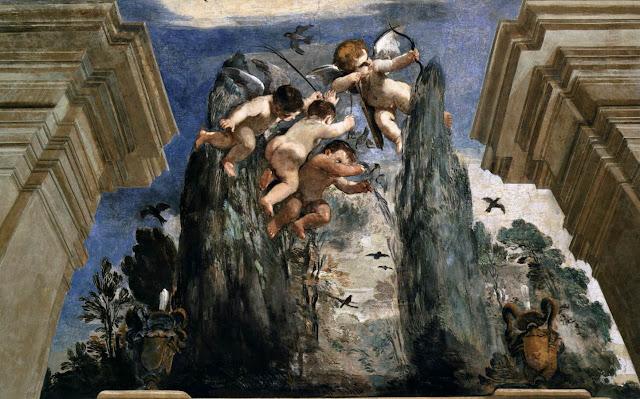 |
| Guercino ceiling decoration in the Sala dell'Aurora 1621 Casino dell'Aurora, Villa Boncompagni-Ludovisi, Rome |
During a long and productive career spanning much of the 17th century, Guercino spent only two years in Rome, from 1621 to 1623. There, he decorated ceilings in a large garden pavilion on the grounds of the Roman palazzo-complex belonging to the family of his countryman and patron Alessandro Ludovisi, recently enthroned as Pope Gregory XV.
 |
| Guercino Portrait of Pope Gregory XV 1622-23 oil on canvas Getty Museum, Los Angeles |
In the long room with coved ceiling the artist and his collaborator Agostino Tassi conceived heavy, inward-curving trompe l'oeil architecture, with the vision of a chariot in the sky floating above. The choice of subject was immediately inspired by a ceiling fresco completed by Guido Reni (for the palazzo of a rival papal family) less than a decade earlier. This vast mural (below) had aroused great admiration. Guercino was hired to surpass it as the centerpiece and namesake of a structure intended by the new Pope as a social setting for official functions, "such as dinners for the College of Cardinals."
 |
| Guido Reni Apollo in his chariot, led by Aurora 1615 ceiling fresco Casino dell'Aurora, Palazzo Pallavicini, Rome |
 |
| Guercino preparatory drawing for ceiling fresco in the Sala dell'Aurora ca. 1621 Staatliche Museen, Berlin |
 |
| Guercino ceiling decoration in the Sala dell'Aurora 1621 Casino dell'Aurora, Villa Boncompagni-Ludovisi, Rome |
 |
| Guercino ceiling decoration in the Sala dell'Aurora 1621 Casino dell'Aurora, Villa Boncompagni-Ludovisi, Rome |
 |
| Guercino ceiling decoration in the Sala dell'Aurora 1621 Casino dell'Aurora, Villa Boncompagni-Ludovisi, Rome |
The illusionistic architecture of receding cornices was painted by the quadratura specialist Agostino Tassi. He executed these looming baroque structures using conventional wet-plaster fresco methods. For sky-scape and figures, Guercino used tempera. This gave him a freedom to blend and refine that resembled his familiar oil technique, retaining a graceful informality that challenged and undercut the monumental seriousness of Guido Reni's prior version. As Diane De Grazia wrote in the 1992 catalog for the Guercino retrospective at Washington's National Gallery of Art – "Guercino's Aurora is the most startling of numerous depictions of the goddess in sixteenth- and seventeenth-century Italian art. Conceived in competition with Guido Reni's representation of the same subject in 1614 in the Palazzo Borghese (now Pallavicini Rospigliosi) and probably suggesting Gergory XV's competition with the previous pope, Paul V Borghese, Guercino's Aurora is one of the first fully developed baroque ceiling decorations. While Reni's Aurora, ethereal and majestically beautiful, is set within a picture frame transferred to the ceiling far above the floor, Guercino's earthly goddess appears to pass close above our heads. In fact, Guercino has capitalized on the proportions of the vault, which are much lower and broader than that of the Pallavicini Rospigliosi. Whereas Reni looked to Annibale Carracci in the Farnese Gallery for his idealization of the goddess and her removal from the spectator by means of the gilt frame, Guercino broke with the Carraccesque tradition to humanize her and her function of bringing on the daylight – and the everyday."
 |
| Anonymous fan-painter Guercino's Aurora ceiling 19th century painted vellum private collection |
 |
| Guercino preparatory drawing of winged figure in chariot 1621 Courtauld Institute, London |
 |
| Guercino painted lunette representing Day in the Sala dell'Aurora 1621 Casino dell'Aurora, Villa Boncompagni-Ludovisi, Rome |
 |
| Guercino painted lunette representing Night in the Sala dell'Aurora 1621 Casino dell'Aurora, Villa Boncompagni-Ludovisi, Rome |
Preceding Guercino's decorative work in the Casino dell'Aurora was the only existing example of a mural executed by Caravaggio. Just before the turn of the century this had been conceived for the same building as the ceiling of a small room (now part of a corridor) used by its then-owner Cardinal Dal Monte as a laboratory. "On the vault, an 'alchemy' scene painted by Caravaggio depicted the various stages of the transformation of lead into gold and showed Jupiter, Neptune, and Pluto above the elements of the universe."
 |
| Caravaggio Jupiter Neptune & Pluto 1597-1600 ceiling mural in oil paint Casino dell'Aurora, Villa Boncompagni-Ludovisi, Rome |
Through Pope Gregory's influence Guercino was also granted a contract for an altarpiece to hang in St. Peter's at the Vatican. He painted an elaborately expressive epic called The Burial of St. Petronilla (below). This was by far the most prestigious commission Guercino – just turned thirty – had so far received. Its public presence effectively established and maintained his reputation in Rome. Yet after 1623 and the death of his patron Gregory XV, the artist never lived in Rome again. He preferred to remain in the Emilian territory of his birth, sending commissions back to Rome from that distance.
 |
| Guercino Burial of St Petronilla oil on canvas 1623 Pinacoteca Capitolina, Rome |
The pair of canvases below with episodes from the life of Christ also came into being during this short Roman sojourn. Both, by chance, now have homes in England. The Taking of Christ at Cambridge borrows numerous elements from Caravaggio's treatment of the same subject painted twenty years earlier. Christ with the Woman Taken in Adultery in London, by contrast, breathes the hard-won harmonies (of pigment and lighting and psychology) that Guercino was assembling for himself.
 |
| Guercino Taking of Christ oil on canvas 1621 Fitzwilliam Museum, Cambridge |
 |
| Guercino Christ with the Woman taken in Adultery oil on canvas ca. 1621 Dulwich Picture Gallery, London |
Altogether, there are now believed to survive about four hundred easel-paintings left splendidly behind by Giovanni Francesco Barbieri (1591-1666), Il Guercino.